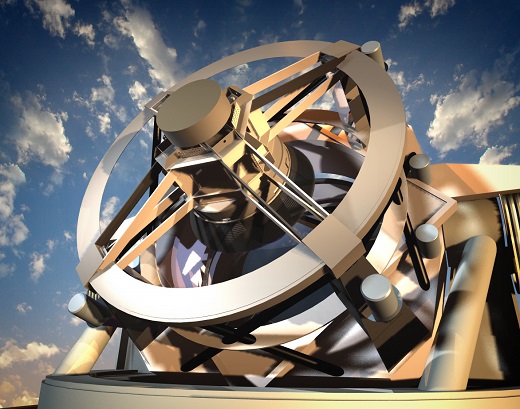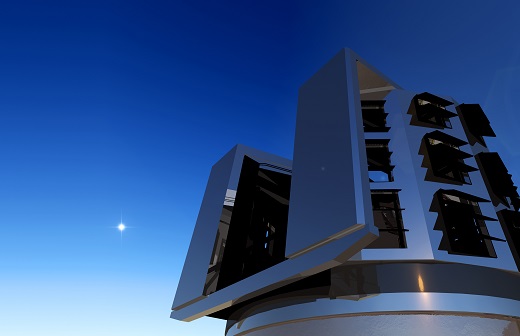Teledyne e2v has been awarded a multimillion-dollar contract by SLAC National Accelerator Laboratory (SLAC) to supply CCD image sensors for the Large Synoptic Survey Telescope (LSST).

The Large Synoptic Survey Telescope will have the largest digital camera ever built for ground-based astronomy. (Credit: Todd Mason, Mason Productions/LSST Corporation)
The 8.4-metre telescope is being constructed in Chile to carry out a 10-year survey of the sky. The images from the telescope will hope to address fundamental astronomy questions about dark matter, dark energy, near-Earth asteroids, transient optical objects such as supernovae, and the formation of the Milky Way galaxy.
Teledyne e2v – the British image sensor company e2v was acquired by Teledyne Technologies in December 2016 – has designed a sensor array with an extremely flat focal surface delivering 3,200 megapixels of image data per exposure.
The array will incorporate 189 large-area sensors, which will be delivered to SLAC for construction into the cryogenically-cooled camera. Approximately one-third of the sensors have already been delivered in a previous contract phase.
This latest contract award follows previous prototype and 'first article' contracts, and requires Teledyne e2v to deliver essential components for the LSST.
The LSST will have the largest digital camera ever built for ground-based astronomy and will be one of the world’s most powerful astronomical survey telescopes when commissioned in 2021. The telescope has a three-mirror design to provide high efficiency and a wide field of view.
SLAC is building the camera that will record images that cover an area of 49 times that of a full moon. The powerful telescope will capture images of the entire sky every few nights in multiple wavelength bands. These will be used to construct a detailed catalogue of the sky, providing brightness, wavelength and time variability information.
‘This telescope and camera will stimulate the astronomy world with a huge survey data set which will be followed by many astronomers worldwide and will set a new standard against which other instruments will be compared,’ said Dr Paul Jorden, astronomy product specialist at Teledyne e2v.
The sensors have very challenging design features and Teledyne e2v has demonstrated that they can be made in large quantities and delivered to a tight schedule.
The sensors have been designed for very high sensitivity and optimised for enhanced red wavelength sensitivity. The camera requires an extremely flat focal surface, and so the Teledyne e2v sensors are designed to achieve a surface flatness precision one-twentieth of the width of a human hair.

The 8.4-metre telescope is being constructed in Chile to carry out a 10-year survey of the sky. (Credit: Todd Mason, Mason Productions/LSST Corporation)
The 189 sensors will be assembled into a closely-packed mosaic to form the three-gigapixel array. There will be only a 0.25mm gap between sensors across the 630mm diameter focal plane.
The sensors have 16 output channels that enable them to read the image in a few seconds and allow a high rate of image collection.
Elsewhere, the University of Exeter in the UK and the University of Michigan in the USA have designed the MIRC-X imager, currently looking at the sky on the CHARA telescope array at the Mount Wilson Observatory in California.
The CHARA telescope is the world's highest-resolution imaging facility in infrared light. The MIRC-X project will combine infrared light collected by six telescopes using a camera from First Light Imaging.
The goal is to image the discs around young stars with infrared interferometry. The discs constitute the left-over material from the star formation process and provide the stage where planets form.
MIRC-X uses the C-Red One SWIR camera developed by First Light Imaging. The camera is based on the Saphira e-APD detector from Leonardo, allowing avalanche amplification and multiplication of electrons. The camera offers 3,500 frames per second, with a read-out noise lower than 1 electron.
So far, the sensitivity of infrared interferometric instruments has been limited primarily by the read-noise of the detectors. The C-Red One's e-APD technology reduces these read-noise contributions by several orders of magnitudes, enabling MIRC-X to detect the faint interference pattern associated with protoplanetary discs.
An advanced infrared detector was also part of the instrument launched recently onboard the Sentinel 5-Precursor satellite. The mission of Sentinel-5P, one of the fleet of satellites within Europe’s Copernicus programme, is to monitor Earth’s atmosphere.
Sofradir’s Tropomi detector is installed in the spectrometer of the same name. The instrument will map numerous trace gases in the Earth’s atmosphere, such as nitrogen dioxide, ozone, formaldehyde, sulphur dioxide, methane, carbon monoxide and aerosols.

